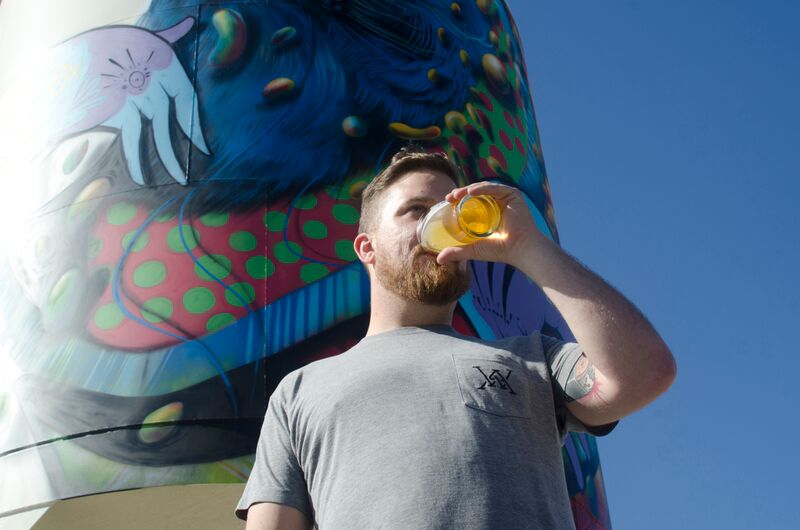Pull Up A Stool with Ben Love
of Gigantic Brewing Co.

Ben Love of Gigantic Brewing Co. in Portland, Oregon. (Photo by Jon Page)
Look! Behind the bar! In the glass! Going down smoothly! It’s GIGANTIC BREWING! Easily recognizable by its cartoonish logo: an oversized G that would look at home on the chest of some over-the-top cartoon superhero. Ben Love, a native Oregonian, earned his stripes with stints at several breweries, including Pelican and Hopworks Urban Brewery, before starting Gigantic with partner Van Havig.
All About Beer: The brewery name says one thing, but just how big are you guys?
Ben Love: This year we’ll brew 3,300 barrels of beer. We have capacity for 4,000 barrels, and we’re adding one more fermenter to get us up to 4,700 barrels. That’s all we have the space for.
So, you’re not actually very big.
The name came out of the fact that we never wanted to get big. We always wanted to stay small. We were trying to come up with a name, and Van, my partner, said “It’s never going to be some fucking gigantic brewery,” and that was it. The name fit. We always planned to stay small, but we also planned to distribute to wide range of places. We’ve always planned to have a larger footprint and sell our beer in 22-ounce bottles.
Given your size, why focus on 22-ounce bottles and not draft?
We make more money off 22-ounce bottles than we do on draft. We can get into more places. Fifteen cases of bottles is one barrel of beer. It’s a lot of bottles to sell. We also need to make sure it is served well. That means the highest quality at the brewery, when we ship, at the distributor’s warehouse, and then on shelves. The key is keeping the inventory low enough to keep the product very fresh.
Your IPA, named Gigantic, and double IPA, called Ginormous, account for about 70 percent of your output. What’s the other 30 percent?
Seasonal beers. Every three months we have two new seasonals at two different price points. One is lower priced the other higher priced. Once we do a beer, we never do it again.
One and done?
All the recipes we do go on to our website, so people can homebrew, or have a friend do it for them. We do get people asking us to redo beers, so I think every five years we’ll do a greatest hits and let people vote on what should come back and be brewed again.
Are you worried that someone might take one of those recipes and release it as their own?
Both Van and I feel there is nothing to hide with the recipes. There is no fear of replication. It’s not really repeatable; those are beers specific to our brew house and fermentation. It would be difficult to repeat it. I really don’t think any brewer out there is going to look at those beers and say, “I’m gonna’ make that beer.” It might inspire, but a brewer would make it their own.
What’s the challenge of having only two regularly released beers?
The biggest challenge in doing different seasonal beers is getting people to try them. We’re building our brand on the hope that no matter what is in the bottle, that the customer will be interested in it and enjoy. We are not building the brand on a specific beer that people have had before. It’s more of a challenge, but it’s more exciting because there is always something new for us. The hardest part is that, without repeating, if it’s a beer we enjoy drinking, it’d be nice to make it again.
Well, you could homebrew it, right? All of the recipes are on your website.
Maybe. We’ll have to contract someone to make those beers for us three barrels at a time for us to drink.
One way you stand out on shelves is your labels. You work with different artists for each new seasonal release?
We thought it would be neat to give artists a canvas, and to interact with the art world, and bring something to the beer from outside of the beer world. Each label is designed to look like outside the comic book. Our logo looks like Super Friends, and we have the staples on the left side. No matter what art we do, there are some consistencies, like a comic series or a magazine.
How do you decide on the art that makes it to the label?
We don’t give the artists any direction, just the beer name. Sometimes the style. They create the art from there, and they pick the quote that goes on the bottle as well. It’s something that should say something about the art more than the beer, but sometimes the quote works for both.
This interview was conducted and edited by John Holl.
Go to the next page to learn more about Ben Love.
John Holl
John is the editor of All About Beer Magazine and the author of three books, including The American Craft Beer Cookbook. Find him on Twitter @John_Holl.

Leave a Reply